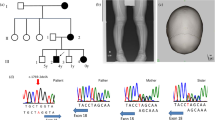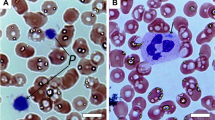Abstract
THE X-linked condition hypoxanthine guanine phosphoribosyltransferase (HGPRT) deficiency may be either gross or moderate in degree and is invariably associated with overproduction of urate in the hemizygote1,2. In addition, however, the gross deficiency state (Lesch–Nyhan syndrome)3 also manifests with mental deficiency, choreoathetosis, spasticity and self-mutilation. Fibroblasts from heterozygotes for the gross deficiency state display mosaicism, some having normal HGPRT activity and others the reduced HGPRT activity characteristic of the hemizygote4. However, HGPRT activity in erythrocyte lysates from such heterozygotes is normal. Heterozygotes for the moderate HGPRT deficiency state, on the other hand, have HGPRT activity in erythrocyte lysates ranging between 20% of normal and completely normal values5. To elucidate this, we have developed an autoradiographic procedure to show HGPRT activity in individual erythrocytes. In families with moderate HGPRT deficiency, in whom erythrocytes of the hemizygote were not significantly labelled by this procedure, heterozygotes showed two erythrocyte populations, one deficient in HGPRT and one containing HGPRT activity. On the other hand, in families whose HGPRT deficiency was gross and manifested as the Lesch–Nyhan syndrome, heterozygotes showed only the normal pattern of labelling. Thus, mosaicism was present in erythrocytes from heterozygotes for moderate, but not for gross, HGPRT deficiency. The former finding supports the Lyon hypothesis6 whereas, the latter finding suggests that either the X chromosome carrying the mutant HGPRT gene is preferentially inactivated, or the X chromosome is randomly inactivated with later selection against the erythrocyte precursors containing the mutant HGPRT enzyme.
This is a preview of subscription content, access via your institution
Access options
Subscribe to this journal
Receive 51 print issues and online access
$199.00 per year
only $3.90 per issue
Buy this article
- Purchase on Springer Link
- Instant access to full article PDF
Prices may be subject to local taxes which are calculated during checkout
Similar content being viewed by others
References
Seegmiller, J. E., Rosenbloom, F. M., and Kelley, W. N., Science, 155, 1682–1684 (1967)
Kelley, W. N., Rosenbloom, F. M., Henderson, J. F., and Seegmiller, J. E., Proc. natn. Acad. Sci. U.S.A., 57, 1735–1739 (1967).
Lesch, M., and Nyhan, W. L., Am. J. Med., 36, 561–570 (1964).
Migeon, B. R., Kaloustian, V. M. D., Nyhan, W. L., and Young, W. J., Science, 160, 425–427 (1968).
Emmerson, B. T., Thompson, C. J., and Wallace, D. C., Ann. intern. Med., 76, 285–287 (1972).
Lyon, M. F., Nature, 190, 372–373 (1961).
Rosenbloom, F. M., Kelley, W. N., Henderson, J. F., and Seegmiller, J. E., Lancet, ii, 305–306 (1967).
Bakay, B., Telfer, M. A., and Nyhan, W. L., Biochem. Med., 3, 230–243 (1969).
Emmerson, B. T., Gordon, R. B., and Johnson, L. A., Q. Jl. Med., 45, 49–61 (1976).
Emmerson, B. T., and Thompson, L., Q. Jl. Med., 42, 423–440 (1973).
Dancis, J., Berman, P. H., Jansen, V., and Balis, M. E., Life Sci., 7, 587–591 (1968).
Nyhan, W. L., Bakay, B., Connor, J. D., Marks, J. F., and Keele, D. K., Proc. natn. Acad. Sci. U.S.A., 65, 214–218 (1970).
McDonald, J. A., and Kelley, W. N., Biochem. Genet., 6, 21–26 (1972).
McKeran, R. O., Howell, A., Andrews, T. M., Watts, R. W. E., and Arlett, C. F., J. neural. Sci., 22, 183–195 (1974).
Author information
Authors and Affiliations
Rights and permissions
About this article
Cite this article
JOHNSON, L., GORDON, R. & EMMERSON, B. Two populations of heterozygote erythrocytes in moderate hypoxanthine guanine phosphoribosyltransferase deficiency. Nature 264, 172–174 (1976). https://doi.org/10.1038/264172a0
Received:
Accepted:
Issue Date:
DOI: https://doi.org/10.1038/264172a0
This article is cited by
-
Selection against blood cells deficient in hypoxanthine phosphoribosyltransferase (HPRT) in Lesch-Nyhan heterozygotes occurs at the level of multipotent stem cells
Human Genetics (1995)
-
Cloned mouse lymphocytes permit analysis of somatic mutations that occur in vivo
Somatic Cell and Molecular Genetics (1987)
-
Age-dependency of somatic selection in South African Negro G-6-PD heterozygotes
Human Genetics (1981)
Comments
By submitting a comment you agree to abide by our Terms and Community Guidelines. If you find something abusive or that does not comply with our terms or guidelines please flag it as inappropriate.



